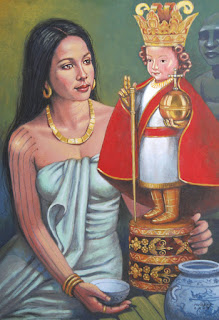 Santonilyo the god of good graces
Santonilyo the god of good gracesLianito (sanskrit:ळिअनितो) also called
Lisantonilyo or santonilyo (corrupted name after the spanish came) is the collective embodiment of the ancestors spirit of a family and territory.
He is a pre-colonial and post colonial deity worshipped and prayed to.
 |
| Hara Humamay and the image of sto.nino by Manuel Panares |
When the head of the family or the mother dies, everyone in the village will help make a wooden idol, they will carve out a child like image and would call it anito or tau-tau. then they would dress the doll and adorn it with gold.
and would place the image among the other idols, some had a hundred idols each representing the dead ancestor.
Santonilyo was the revised name for this deity, the anciet Visayans called the child Lianito.
Ancient Visayans believed that some part of their relative or ancestors soul would join together and form Lianito depicted as a child, androgynous and always smiling, that gives them good graces and aids in a bountiful harvest or catch. The image of Lianito or Lisanotniloyo are called tao-tao/tawu-tawu or wooden idols were common in pre-colonial philippines, some had a hundred of these wooden idols adored in gold and offered flowers. When the Spaniards came to the Philippines they showed and gave the queen of Sugbu Hara Humamay the image of baby Jesus (santo Nino) the queen perhaps wanted it for it look more refined and human-like than the wooden idols, the asked it as a token of their friendship from the Spaniards.
Mga Komento
Mag-post ng isang Komento